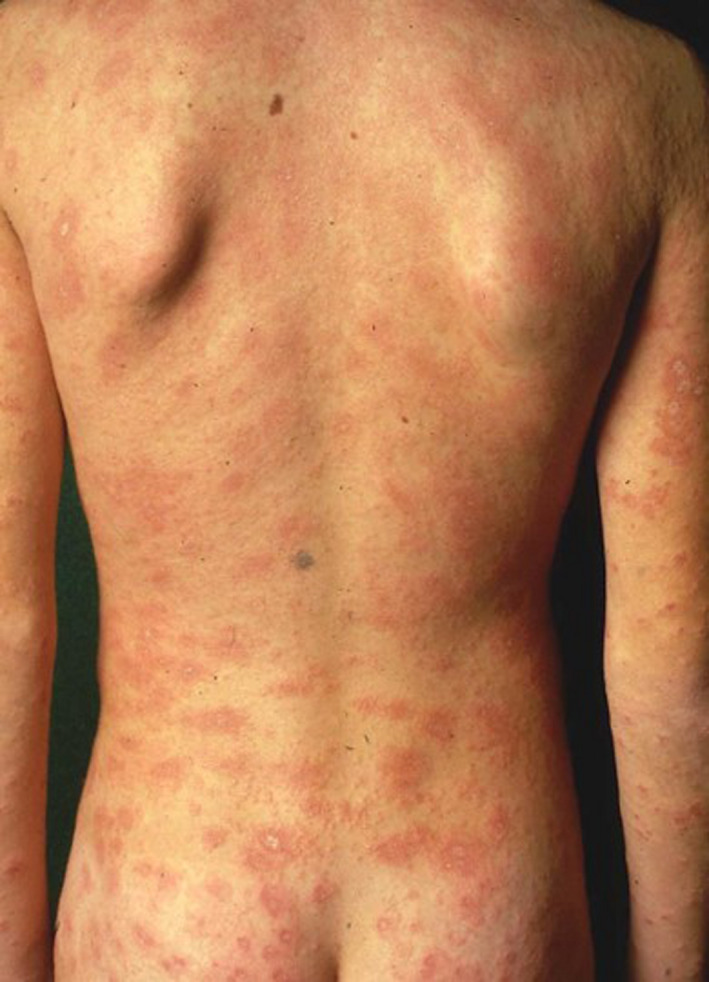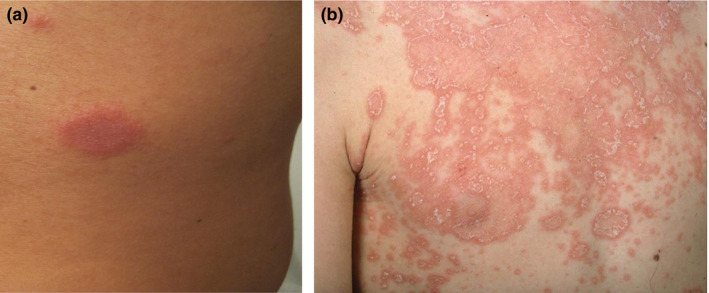Dear Editor,
Pityriasis rosea is an acute, exanthematous disease likely caused by human herpesvirus HHV‐6 and/or HHV‐7. 1 , 2 It mainly affects young adults. We present two cases of pityriasis rosea‐like eruptions associated with COVID‐19 infection.
A 26‐year‐old man was admitted with a diagnosis of pityriasis rosea. The patient was in good general health and was not on therapy with systemic drugs. He stated that the rash appeared some days earlier and was accompanied by pruritus. He also complained of mild headache, weakness and arthralgia. Dermatological examination revealed several erythematous‐squamous papules and plaques located mainly on the upper limbs and trunk (Fig. 1). A diagnosis of pityriasis rosea‐like eruption was made. Laboratory tests (including complete blood cell, liver and renal function, inflammatory markers, syphilis serology) showed only slight increase of erythrocyte sedimentation rate. Nasal swab was positive for SARS‐CoV‐2. Chest X‐ray was normal. Cetirizine (10 mg/day) was prescribed. The patient was followed at his home. Skin lesions and other symptoms resolved within three weeks.
Figure 1.

Patient 1. Several erythematous‐squamous papules and plaques located on the upper limbs and back.
A 21‐year‐old man was admitted because of the appearance of a single infiltrated, erythematous, oval lesion located on the left hip (Fig. 2a). Mycological examination was negative. A diagnosis of herald patch of pityriasis rosea was made. No treatment was suggested. One week later, the patient returned with a widespread erythematous‐squamous rash on the chest and back, with lesions of different morphology and size (Fig. 2b). The patient complained of pruritus. Furthermore, the patient reported anorexia, abdominal pain, diarrhoea and weakness. We performed nasal swab for SARS‐CoV‐2, which was positive. All the other laboratory examinations were within normal ranges or negative. Also, this patient was followed at home and treated with cetirizine (10 mg/day). Both the rash and symptoms subsided within three weeks.
Figure 2.

Patient 2. (a) Herald patch. (b) Widespread erythematous‐squamous rash on the chest, with lesions of different morphology and size.
Various cutaneous manifestations have been associated with COVID‐19. 3 , 4 In addition to our cases, one other case of a pityriasis rosea‐like eruption has also been reported. 5 The cases we have described show a temporal relationship between pityriasis rosea or pityriasis rosea‐like eruption and COVID‐19, but they do not prove causality.
Funding: none.
Conflict of interest: none.
References
- 1. Drago F, Broccolo F, Rebora A. Pityriasis rosea: an update with a critical appraisal of its possible herpesviral etiology. J. Am. Acad. Dermatol. 2009; 61: 303–18. [DOI] [PubMed] [Google Scholar]
- 2. Drago F, Ciccarese G, Rebora A et al. Pityriasis rosea: a comprehensive classification. Dermatology 2016; 232: 431–7. [DOI] [PubMed] [Google Scholar]
- 3. Gianotti R, Veraldi S, Recalcati S et al. Cutaneous clinico‐pathological findings in three COVID‐19‐positive patients observed in the metropolitan area of Milan, Italy. Acta Derm. Venereol. 2020;100:adv00124. [DOI] [PMC free article] [PubMed] [Google Scholar]
- 4. Sachdeva M, Gianotti R, Shah M et al. Cutaneous manifestations of COVID‐19: report of three cases and a review of literature. J. Dermatol. Sci. 2020; 98: 75–81. [DOI] [PMC free article] [PubMed] [Google Scholar]
- 5. Ehsani AH, Nasimi M, Bigdelo Z. Pityriasis rosea as a cutaneous manifestation of COVID‐19 infection. J. Eur. Acad. Dermatol. Venereol. 2020. 10.1111/jdv.16579. [DOI] [PMC free article] [PubMed] [Google Scholar]


